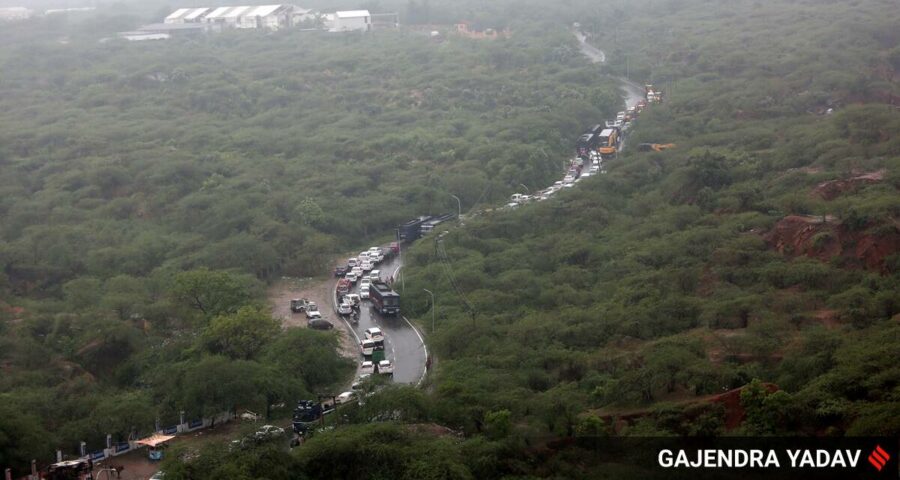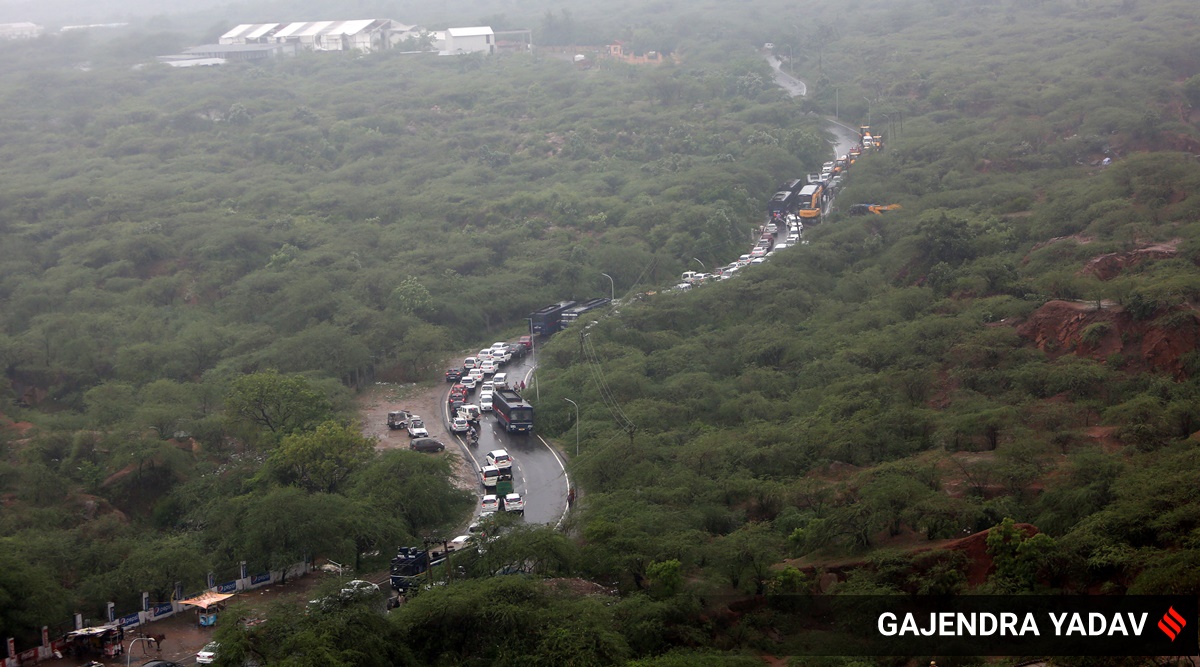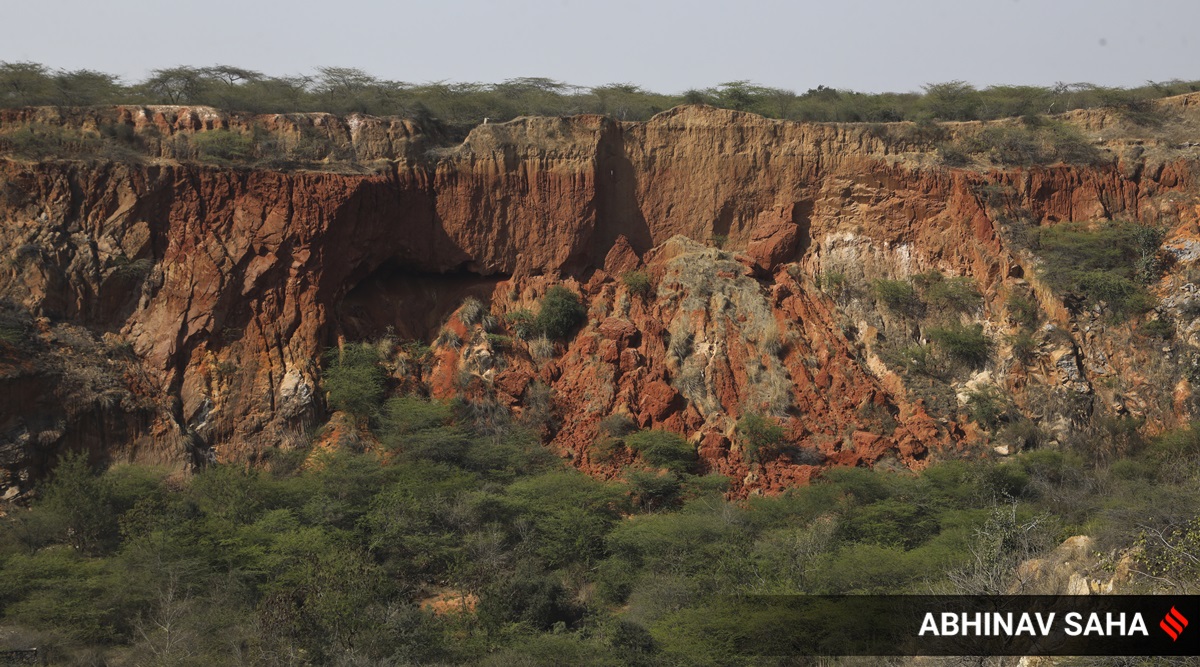The Haryana government says if it implements an order passed by Supreme Court in 2018, all the structures that stand on 40 per cent of state’s geographical area would have to be demolished. The state is now again looking to apex court for clarity, and further directions
The Aravallis range, which has been a bone of contention between the state governments and environmental activists since long, is in the spotlight once again as the Supreme Court gets ready to take up Haryana’s contention that area “erroneously” considered part of forest land should be declassified. It is an argument that environmental activists dismiss as a move aimed at benefitting the real-estate developers.
The state government has been facing a challenge of identifying the areas that actually can be construed as “forest land”.
Going by various Supreme Court judgments, if those have to be implemented in letter and spirit, at least 40 per cent of the state’s area will come under the definition of a forest land and all structures raised on that land would be required to be demolished. The case is pending litigation in the Supreme Court and it comes up for hearing on November 15.
THE LEGAL TANGLE
Haryana government had recently filed an affidavit in the Supreme Court in which it mentioned that around 40 per cent of the state’s area comes under the forest land and all the areas covered under Punjab Land Preservation Act cannot be considered as “forest land”.
The government has also said that if it implements SC’s 2018 verdict (Faridabad’s housing colony Kant Enclave demolition case), it would mean that all the structures that stand on 40 per cent of the state’s geographical area would required to be demolished.
Expressing its inability to follow the verdict and citing “unparalleled law and order problems” that could emanate if the government attempts to implement the verdict, the state government has now requested the Apex Court for further directions. The case now comes up in Supreme Court on November 15.
In multiple cases, from time to time, including in three prominent cases including first in 2002, then in 2018 and recently in July, 2021, the SC had ruled that “all areas notified under Sections 3, 4 and 5 of the PLP Act are forest land including where the validity period of the notification has expired. Every structure constructed on such land after issuance of any notification under the provisions of the PLP Act are illegal structures and are required to be demolished”.
On July 23, a bench of Justices AM Khanwilkar and Dinesh Maheshwari directed the Haryana government to ensure that all unauthorised structures standing on Aravali forest land should be cleared.
“Our direction to remove all structures on forest land applies to all structures without any exception,” stated the directive.
On September 20, the Supreme Court directed Haryana government to file the affidavit, while hearing a case filed by Satpal and others versus Union of India and ruled: “We call upon the State of Haryana to file affidavit by authorised official to clearly state about the factual basis as to how the area has been first notified as forest area, be it under Union enactment or the state enactment, as the case may be, and also related matters which can be taken into account for answering the controversy in issue.”
Abiding by the SC’s verdict, Haryana’s Additional Principal Chief Conservator of Forests filed this affidavit and apprised the court of the multiple notifications that were issued from time to time declaring forest land in the state and why all the structures on the land covered under PLPA cannot be removed.
The state government told the court that total area of 17,39,907 hectares (39.35 per cent of the total geographical area of the state) has been notified under Sections 3, 4 and 5 of the Punjab Land Preservation (PLPA) Act. This includes 100 per cent area of at least 11 districts out of total 22 districts of the state — Panchkula, Ambala, Yamunanagar, Gurgaon, Faridabad, Palwal, Mewat, Mahendragarh, Rewari, Bhiwani and Charkhi Dadri.
Giving reference to Apex Court’s judgements in multiple cases, Haryana government said that, “About 39.35 per cent of the geographical area of Haryana, being notified under the provisions of the PLP Act are required to be considered as forest and every structure constructed after issuance of the notification for the first time are required to be considered as illegal and are required to be demolished,” the affidavit adds.
In 2014, the Haryana government had approached Supreme Court in MC Mehta and other bunch of cases where the court was considering protection of Aravali forest land. Haryana, at that time, moved an application seeking clarification that land notified under expired notifications or orders passed under Section 4, 5 of PLPA should not be treated as forest.
This plea is yet pending consideration of the Apex Court. In February 2019, following the Kant Enclave judgment, Haryana Vidhan Sabha passed an amendment to PLPA and excluded certain lands meant for construction, out of the ambit of PLPA notification. But, on March 1, 2019, it was also stalled by the Supreme Court that ruled: “No action is to be taken by the Haryana government in furtherance of the PLPA (Amendment) Act, 2019”.
THE CHALLENGE FOR GOVT
In the case of MC Mehta (Kant Enclave matter) versus Union of India in 2018, and the order passed by Supreme Court pertaining to Khori village case, the court had ruled that “all areas notified under Section 3, 4 and 5 of the PLP Act are required to be considered as forest and structures standing thereon are required to be considered as illegal, unless requisite permission under Forest Conservation Act is obtained, and liable to be demolished”.
Ever since Haryana government demolished the slum colony of Khori village in Faridabad and issued showcause notices to owners of 129 farmhouses, banquet halls, schools, religious institutions, and commercial structures, the issue started to snowball. A number of those 129 owners who were served notices claimed that their premises were outside the forest area. However, state government dismissed their objections citing the rule that the land was notified under the PLP Act and was being considered a “forest land”.
WHAT GOVERNMENT SAYS
The government says that the circumstances have changed during 118 years after introduction of the PLPA and it was important to the bring change in the law to prevent constructions like Kant Enclave of Faridabad. According to the statement of Haryana Forest and Wild Life Minister Narbir Singh to the Assembly, there was no provision in PLPA to provide reasonable opportunity of being heard before imposing restrictions under the Act. As per new provisions, new objections can be filed by ‘any person interested in any land which has been notified’ against the government move seeking changes in notification.
THE OWNERSHIP TANGLE
In July, Haryana’s State Information Commission asked state’s Revenue Department to intervene and constitute committees of multiple departments to ascertain the “correct ownership” of 60 farmhouses that have been allegedly illegally built in Aravali area in Gurgaon and Faridabad districts.
The actual ownership of these farmhouses continues to remain a mystery as government’s multiple departments have been throwing the ball into each other’s court for past many months. Dakshin Haryana Bijli Vitran Nigam had submitted to the SIC the details about the electricity connections given to these farmhouses. However, they too failed to divulge any details about the correct ownership of the farmhouses. It is, however, learnt that the farmhouses where DHBVN had given electricity connections do not have permission under the Forest (Conservation) Act or Controlled Area Act.
The forest department, though, did give a few names (that own majority between 2 to 18.5 acres of land area), but added that the “actual and real ownership” could only be verified from the revenue records. In a scathing order passed recently, the State Information Commission has asked Financial Commissioner (Revenue) that the “committees consisting of concerned officers of Faridabad and Gurgaon districts i.e. District Forest Officer, District Town Planner, District Revenue Officer and Executive Officer, Municipal Corporation may be constituted to ascertain the correct ownership of the farm houses in Aravali Area — specifically the 60 farmhouses falling under their jurisdiction and submit the report within a reasonable time frame, preferably, within two months of receipt of this order”. In its earlier order on January 15 in the same matter, the State Information Commission has “frowned” upon the public authority and called the denial of information as a “shameless disregard for accountability”.
The case pertains to 60 farmhouses, regarding which senior IAS officer Ashok Khemka had filed an RTI application seeking details of ownership.
The RTI application was filed by Khemka on February 28, 2020, on the basis of a minister’s reply in the Vidhan Sabha against a question raised by MLA Seema Trikha. The MLA had sought information about illegal farmhouses in Aravalli region and what action the government was taking, to which forest minister Kanwar Pal had given a list of 60 such farmhouses but names of owners were not mentioned.
Haryana’s Principal Secretary (Town and Country Planning) A K Singh submitted to the Commission that “out of total 60 alleged farm houses, 54 farm houses falls within the jurisdictions of Urban Local Bodies and Forest Department (due to applicability of the notification relating to Section 4 & 5 of PLPA, 1900 on all the khasra Nos. mentioned in the list of RTI application of the appellant). Therefore, only 6 (six) Nos. of alleged farm houses in the revenue estate of Damdama (Gurgaon), Khedla (Gurgaon), Kot (Faridabad) are falling in the work jurisdictions of both the SPIOs of TCP Department…”.
However, showing dissatisfaction over Singh’s reply, the Commission observed, “After perusal, the Commission is of the view that the reply given by Shri A.K. Singh, IAS, Principal Secretary is contrary to the reply given by the Hon’ble Minister in the Vidhan Sabha. Therefore, to ascertain the correctness of ownership of farm houses, the Commission is of the view that a committee should be formed”.
Haryana says half of its districts will be notified as forest
The Haryana government, in its affidavit, had apprised the Supreme Court that total area of 17,39,907 Ha (39.35 per cent of the total geographical area of the State) has been notified under Sections 3, 4 and 5 of the Punjab Land Preservation (PLPA) Act. This includes 100 per cent area of at least 11 of the 22 districts including Panchkula, Ambala, Yamunanagar, Gurgaon, Faridabad, Palwal, Mewat, Mahendragarh, Rewari, Bhiwani and Charkhi Dadri.
Giving reference to the Supreme Court judgments in multiple cases, the state has said that, “About 39.35 per cent of the geographical area of the State of Haryana, being notified under the provisions of the PLP Act are required to be considered as forest and every structure constructed after issuance of the notification for the first time are required to be considered as illegal and are required to be demolished.”
If Supreme Court’s directives are followed, Haryana says many critical establishments like the CRPF Group Centre, Terminal Ballistic Research Laboratory and Test Range, ITBP Corporate Office, and Chandimandir Cantonment (all in Panchkula), the Indira Gandhi Super Thermal Power Plant in Jhajjar, Deen Bandhu Sir Chhotu Ram University of Science and Technology and CRPF Camp in Sonipat, Gurgaon Air Force Station, Tata Energy Research Institute and National Institute of Solar Energy along with hundreds of headquarters of multinational companies, hundreds of government offices, hospital and educational institutes in Gurgaon and National Secruity Guard complex in Manesar would have to be razed.
Source: Read Full Article




